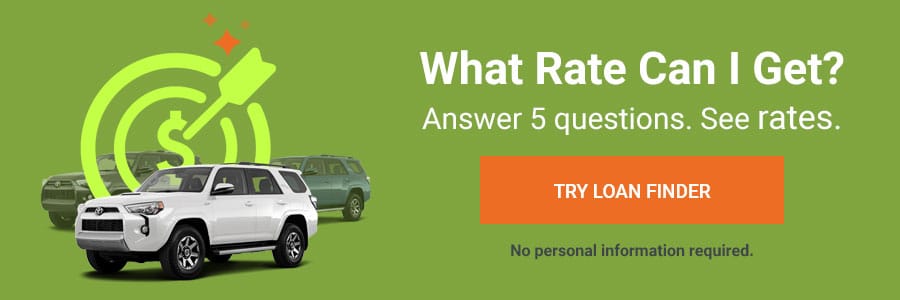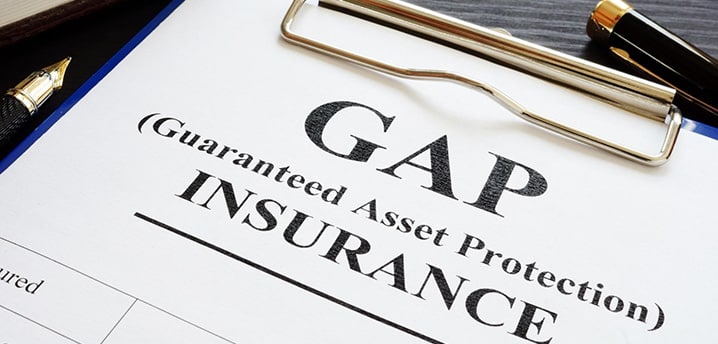Car insurance might not cover your loan balance after an accident. GAP insurance bridges that gap.
Buying a new car is exciting. It lets you say goodbye to that constant tick-tick sound your engine makes when you’re cruising down the road or replace your gas guzzler with something more eco-friendly.
But new cars aren’t cheap. The average new car sells for $48,000 — a record high — which is partly why 81% of car buyers finance new car purchases.
What happens if your new vehicle is totaled or stolen and you suddenly find yourself responsible for paying off your remaining loan balance? Though car insurance covers most losses, payouts are based on the vehicle value, not your loan balance.
If you owe more than what your car’s worth, you’ll need to make up the difference to your lender. GAP insurance covers the gap between what insurance pays and your remaining loan balance, but it’s not always the most effective solution.
Let’s look at when GAP insurance on a car is worth it and when you’re better off with something else.
📌 Key takeaways about the benefits of GAP insurance:
- If your car is totaled, the payout you receive from your insurance company might not be enough to pay off your remaining auto loan balance.
- GAP insurance bridges the gap between your insurance payout and what you still owe on your car loan.
- GAP insurance is worth it for borrowers with a high loan-to-value ratio, a vehicle with a high depreciation rate, an underwater loan, and other situations in which the car’s value is less than the loan balance.
- Shopping around for GAP insurance and alternative products helps you secure the best and most effective deal for your financial situation.
What Is GAP Insurance?
GAP insurance, or Guaranteed Asset Protection, is a standalone or supplemental insurance coverage option that pays out the difference between your auto insurance payout and remaining loan balance after a covered loss.
A GAP insurance policy can be purchased at any time. GAP insurance is usually optional, though some lenders require borrowers to purchase coverage before financing a car loan. This requirement is more common if your loan-to-value (LTV) ratio exceeds 100%, which means the balance of your loan exceeds your car’s value.
Car (LTV) Loan-to-Value Calculator
A loan-to-value ratio over 100% means you owe more on your loan than your vehicle is worth. An LTV over 125% can make it harder, but not impossible, to qualify for a refinance loan.
If your LTV is less than 100%, your car's value is higher than what you owe on your loan. The lower your LTV, the better.
GAP insurance vs. GAP waivers
The terms GAP insurance and GAP waivers are often used interchangeably, but they’re both different products that provide similar coverage.
GAP insurance pays out a monetary amount equal to your remaining loan balance after car insurance pays out your car’s actual cash value (ACV) to your lender. Your lender receives the lump sum payment, marks your loan as paid, and things return to normal.
A GAP waiver waives your remaining loan payments — you simply don’t need to pay the difference. In most cases, the amount that can be waived is capped at some percentage of your LTV up to a specified amount, such as 150% and $50,000.
GAP insurance and GAP waivers also differ in how and when you can buy coverage. Because GAP insurance is an insurance policy, you can purchase it at any time from an insurance company. On the flip side, lenders and finance companies sell GAP waivers when you buy a new car, letting you roll its cost into your loan balance.
Buying GAP insurance gives you more freedom to shop around for a policy (like shopping around for car insurance), but you’re responsible for paying monthly premiums. Missing payments can cause your policy to lapse, which can make GAP insurance riskier than a waiver.
In contrast, GAP waivers remain active for the duration of the loan, or until you cancel coverage or file a claim.
How Does GAP Insurance Work?
GAP insurance is an add-on, which means it kicks in after your existing auto insurance policy. The typical process looks like this:
- Your car insurance company deems your car totaled after a covered event (like an accident or theft).
- Your comprehensive insurance (which covers losses incurred by non-accidents) or collision insurance (which covers losses incurred from an accident) pays out the car’s ACV to your lender, minus your policy deductible.
- GAP insurance pays off the remaining loan balance to your lender.
The actual cash value of your car is its total worth in its current condition, including the impact of depreciation. ACV is almost always less than your car’s purchase price. If the cost to repair your car exceeds 51% to 80% of its ACV, your insurer will likely deem it totaled.
Let’s look at how GAP insurance works in the event you buy a car for $30,000, roll your previous balance of $2,500 into it (creating an upside-down car loan), and then get into an accident in which your car is totaled:
| Original loan balance |
$32,500 |
| Remaining loan balance (after one year, at time of accident) |
$28,000 |
| ACV paid out by comprehensive coverage/collision coverage |
$25,000 |
| Difference between loan balance and ACV |
$3,000 |
| Car insurance deductible |
$1,000 |
| What you owe |
$4,000 ($3,000 difference + $1,000 deductible) |
If you maintained active GAP insurance, your policy would pay out the $3,000 difference between your car’s ACV and your remaining loan balance, leaving you responsible for your car insurance deductible of $1,000 (unless your policy covers your deductible as well).
Bear in mind that GAP insurance, like regular insurance, doesn’t pay out the replacement cost value — the cost of replacing your vehicle with a new one of similar value.
According to RateGenius data, the average GAP claim in 2021 was $2,594.00.
*Due to reduced driving during the pandemic, this number was lower than a typical year. For reference, the average GAP claim in 2019 was $3,410.23.
What doesn’t GAP insurance cover?
GAP insurance only pays out when your vehicle is declared a total loss, and limits its payout to the difference between your car’s ACV and your remaining loan balance (up to the limitations of your policy).
A GAP insurance policy might also have some coverage exclusions depending on the insurance company you buy it from. Some common GAP insurance exclusions are:
- Overdue car payments
- Lease penalties, such as excess mileage charges
- Non-refunded security deposits
- Premiums paid for other insurance purchased with the loan or lease
- Extended warranty costs
- Amounts deducted by your car insurance company for wear-and-tear, past damage, towing, or storage
- Carryover balances from previous loans or leases
- Aftermarket equipment or modifications
- Used cars older than two or three years
- Borrowers who are not the original owner
Remember: Not all GAP insurance policies are alike. Before purchasing a policy, read through its provisions and shop around if a specific policy wouldn’t provide you with the comprehensive coverage you’re looking for.
Do I Need GAP Insurance?
Unlike car insurance, GAP insurance isn’t legally required. However, there are situations when GAP insurance coverage is a good investment, particularly if you:
- Didn’t make a down payment, or made a small down payment of less than 20%
- Financed a long loan term — typically 48 months or more
- Are leasing a car (which is usually a requirement)
- Have an upside-down car loan with negative equity (typically from rolling over an old loan into your new one)
- Purchase a car that depreciates quicker than the average vehicle (the value of a new car typically depreciates by 20% within the first year)
- Drive a lot (which contributes to depreciation)
If you already bought a car and don’t currently have GAP insurance coverage, you can use tools like Kelley Blue Book and Edmunds to estimate the ACV of your vehicle. Compare that estimate to your remaining loan balance. If you owe significantly more than your car’s worth, you might want to consider buying GAP insurance.
How long do I need to keep GAP insurance?
You don’t need to maintain GAP insurance forever. Like other types of insurance, GAP requires you to pay a monthly premium to keep your policy in force. However, GAP coverage stops being useful after:
- Paying off your car loan
- Your LTV falls below your remaining loan balance
After reaching either of these milestones, contact your auto insurance company to cancel your GAP insurance — it would no longer serve any purpose. If you paid your premium in full upfront, you might receive a prorated refund.
How To Buy GAP Insurance
GAP insurance is sold by insurance companies as either a standalone policy or an endorsement to auto insurance.
When shopping for GAP insurance, be mindful of the type of coverage you’re being offered. Car dealerships, banks, credit unions, and other lenders often recommend or offer GAP insurance, though use the term interchangeably with “GAP waiver.”
To purchase a policy, request quotes from major auto insurers and GAP insurance companies, including your existing insurance provider. This helps you find a policy that meets both your needs and budget.
How much does GAP insurance cost?
According to the Insurance Information Institute, GAP insurance can cost as little as $20 per year when added as an endorsement to your car insurance policy.
However, your mileage may vary (no pun intended). GAP insurance rates depend on the same underwriting factors as auto insurance, so they can fluctuate depending on the size of your loan, the type of vehicle you’re financing, and other considerations.
Typically, insurance companies calculate the cost of GAP insurance between 5% and 6% of your auto insurance policy. This generally translates to about $50 to $150 per year on top of your car insurance premium.


GAP Insurance Alternatives
GAP insurance is helpful, but it does have its limits. Depending on your situation and finances, you might be better suited with some form of alternative coverage.
GAP waiver
Unlike GAP insurance — which can be purchased at any time — GAP waivers are purchased at the same time you finance or refinance a car loan. This means you can roll the cost of GAP into your loan, ensuring that your coverage never lapses for nonpayment of your insurance premium.
GAP waivers function similarly to insurance (which is why the two terms are so often used interchangeably, if incorrectly). Compare the cost and convenience of a GAP waiver to a standalone policy or endorsement to help decide which is best for you.
Loan/lease payoff coverage
If the confusion between GAP insurance and GAP waivers isn’t enough, another contender enters the ring. Loan/lease payoff coverage is essentially a watered-down type of GAP coverage that limits its payout to 25% of your vehicle’s ACV, though you would still be responsible for your car insurance deductible.
Unlike some GAP insurance policies, loan/lease payoff coverage can be purchased at any time — even for used cars. Loan/lease payoff coverage is less commonly offered by insurance companies, but it could be a compelling alternative to GAP insurance depending on your situation.

New car replacement insurance
In contrast to GAP insurance, new car replacement insurance is add-on coverage that replaces your totaled car with a brand new vehicle after a covered event. This is especially useful for borrowers with new or barely used vehicles for whom getting back on the road would be costly after a total loss — even with GAP insurance.
However, new car replacement coverage can be limited, depending on the insurance company you buy from. Typically, your vehicle must be relatively new — generally under five years old, though often even newer — and have low mileage. You might also be required to maintain a car insurance policy with full coverage.
Some insurance companies also offer “better car replacement insurance,” which promises to pay for a new, better car trade-in following a covered event.
Refinance your car loan
An auto loan refinance replaces your existing car loan with a new one. Though this doesn’t help you cover the gap between your vehicle’s ACV and your remaining loan balance, it can help you secure a lower interest rate, shorter loan term, and more affordable monthly payment, potentially reducing — or even eliminating — your need for GAP insurance.
However, if that need still exists, many lenders let you purchase a GAP waiver at the time of refinancing.
Got a Gap? GAP Insurance Might Be Worth It
Financing a car is expensive, even though your shiny new car starts depreciating the moment you drive off the lot. Making up the difference between its actual cash value — which constantly drops — and a potentially sizable loan balance could be difficult, if not impossible.
GAP insurance bridges that gap. Though you’re still on the hook for getting yourself a new set of wheels, you can do so with a clean slate, without the risk of needing to wrap your remaining loan balance into a new one (and starting with negative equity) or paying off two car loans at the same time.
;)




